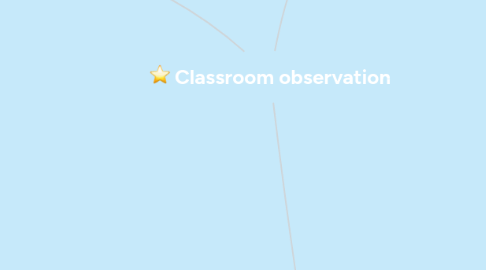
1. Peer Observation and Reflection in the ELT Practicum
1.1. Does Peer Observation (PO) led to reflective teaching?
1.1.1. Did PO help the students engage in reflective teaching?
1.1.1.1. The peer observation activity helped me to reflect on my teaching beliefs and practices.
1.1.1.2. "Showed remarkable differences".
1.1.1.3. Helped to become more aware and also helped to notice little things.
1.1.1.4. Allowed them to look at a specific point of their practice and to reflect on that.
1.1.2. What were the students’ reactions to PO?
1.1.2.1. An encouraging result as these students do not feel that an observer in the classroom is a threat or a negative experience.
1.1.2.2. "It helped to reflect my teaching".
1.1.2.3. Comprehend different ways of thinking and teaching.
1.1.3. Would engaging in reflective teaching in the practicum generalize to subsequent teaching experiences?
1.1.3.1. "Because of the peer observation activity, I changed some of my teaching behaviors or practices".
1.1.3.2. Aware about reducing teacher talk time and increasing student talk time.
1.1.3.3. Get ideas.
1.1.3.4. Copy strategies.
1.1.4. Did the students modify their teaching behaviors or practices because of PO?
1.1.4.1. "Because of the peer observation activity, I changed some of my teaching beliefs."
1.1.4.2. Discipline is important.
1.1.4.3. Able to learn more about how beliefs and assumptions of teaching were present in their own teaching.
1.1.5. Did the students change any of their teaching beliefs because of PO?
1.1.5.1. To what extent, if any, did the PO help you engage in reflective teaching?
1.1.5.1.1. Engaging in reflective teaching,
1.1.5.2. Do you think that the PO might help you engage in reflective teaching when you begin to teach?
1.1.5.2.1. They would engage in reflective teaching in future teaching assignments.
2. Classroom observation in teaching practice
2.1. The observer can take different focus to discuss after, with the cooperating
2.1.1. Different focus like
2.1.1.1. Motivation
2.1.1.2. Clear explanation
2.1.1.3. Correct feedbacks
2.1.1.3.1. What is really important ?
2.1.1.4. Class preparation
2.1.1.5. Methodology
2.2. In a classroom obsevartion consider...
2.2.1. The teacher prepare more his/her class to a normal day
2.2.2. The teacher guide the class depending of his/her personality
2.3. Observation procedures
2.3.1. Checklist
2.3.2. Seating charts
2.3.3. Field notes
2.3.4. Narrative summary
2.3.5. Cooperating teacher's conversation
2.4. Being observed
2.4.1. Socialize with the supervisor is significant
2.4.2. Use video or tapes can help for future classes
2.4.3. Mistakes are important to learn
2.5. How I interact with the class?
2.5.1. The supervisor give a feedback about problems and objectives achieved
2.5.1.1. Give a new goal for the next class
2.5.2. The supervisor can take notes about
2.5.2.1. Gesture of the students and the teacher
2.5.2.2. When to visit
2.5.2.2.1. When introduce the class
2.5.2.3. The best vantage point
2.5.2.4. Adopting the best "bedside manner"
2.5.2.4.1. How manage the class
2.6. The observation in the L2 classroom.
2.6.1. Teaching and observation
2.6.1.1. Evaluate teaching in order to determine the weak points of the teacher.
2.6.1.2. Learn the trade through observation.
2.6.1.3. Learn to observe, be it our own work or that of our colleagues.
2.6.1.4. Observe to be considered of our own daily work.
3. An introduction to a classroom observation
3.1. Show the purposes, uses and methods for a good observation, and how recording it
3.1.1. Teacher and pupils
3.1.1.1. Pupils can be jokers, collaborators,investigator, servants and others
3.1.1.2. Teachers can be counsellor, social worker, assesor, manager
3.1.1.2.1. Teacher can use differente elements like, media, books, test, grapichs etc.
3.1.2. Methods
3.1.2.1. Quantitative methods
3.1.2.1.1. Learned-center
3.1.2.1.2. Teacher-center
3.1.2.1.3. Teacher's engage
3.1.2.2. Qualitative methods
3.1.2.2.1. Teacher- students interaction
3.1.2.3. Animal behaviour
3.1.2.3.1. Has a relation how we learn to
3.1.2.3.2. Agression guide
3.1.2.3.3. Non-verbal uses
3.1.3. Observer
3.1.3.1. Observer need a Focus specifically
3.1.3.1.1. Management of teacher
3.1.3.1.2. Teacher-students relation
3.1.3.1.3. Comunnication
3.1.3.2. Notes depend on
3.1.3.2.1. Subjective role
3.1.3.2.2. Environment
3.1.3.3. Recording observation
3.1.3.3.1. Can use different methods with advantages and disadvantages like
